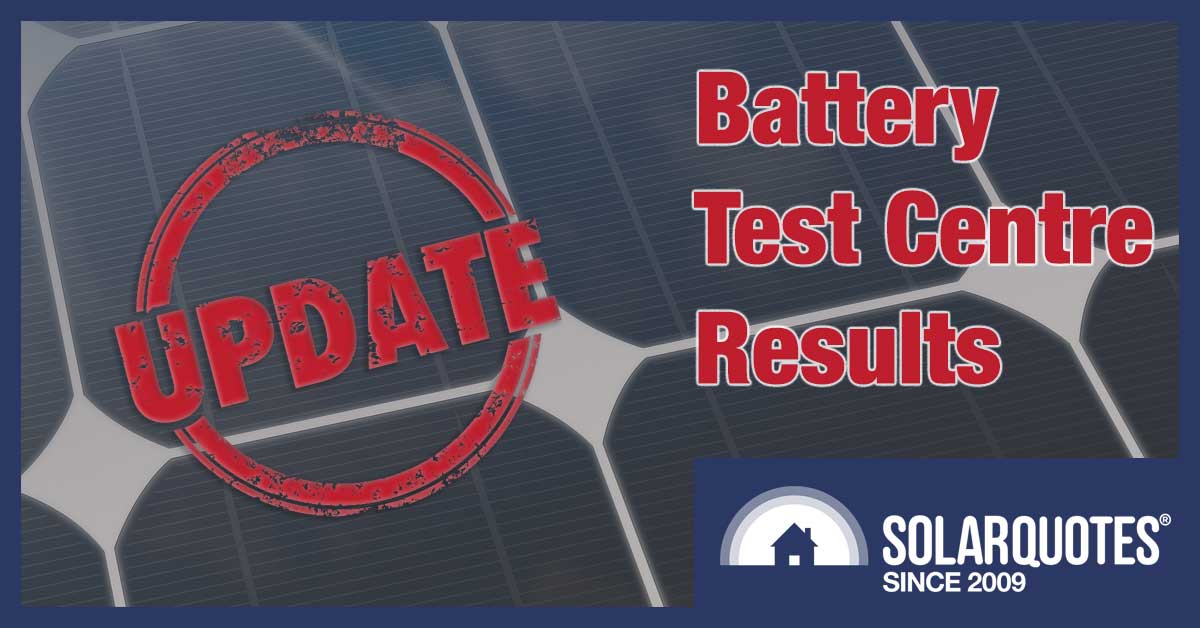
The results show some big name batteries performing pretty poorly…
The Lithium Ion Battery Test Centre in Canberra has released a new report. They released it 5 months ago but I’ll make apologies for tardy reporting later.
Last year I wrote a long article on the Battery Test Centre. It was titled, “Worrisome Results From Canberra’s Battery Test Centre” because only 10 out of the 18 battery systems tested operated without problems.
At the time I didn’t count battery deterioration as a problem, but this new report goes into detail on the topic. One-third of the batteries in the report clearly show unacceptable reductions in capacity. The worst was the German GMB LFP battery that lost more than 1% of capacity per month of simulated testing. Taking this new information into account means less than half the batteries purchased for testing stored and supplied electrical energy as they were designed to.
Goddammit batteries! You had one job!
The good news is you can greatly increase your chances of getting a battery system that works by buying one made by a manufacturer with a good reputation. According to the results of the latest report there are a few brands that have done well when in the area of capacity deterioration or “fade” as it’s sometimes called. Of the systems accessed, those that suffered the least deterioration were:
- The BYD B-Box.
- The Samsung Energy Storage System — now replaced by the Hansol AIO.
- The Sony Fortelion, which no longer appears to be sold in Australia.
While it didn’t perform nearly as well as these three, I will mention the LG RESU10H is on track to be safely above the minimum 60% of original capacity its warranty allows after approximately 9.3 years of daily cycling.
I Am Totally Tardy
The Lithium Ion Battery Test Centre produces 6 monthly reports every 6-8 months. They’re a bit rando when it comes to the exact number of months in 6 months.
But just because they’re a little flexible on how many months are contained within 6 months doesn’t mean I don’t seem slack for only writing about it now. After all, the report came out back in the dark days when Dean Lewis’s “Be Alright” was still considered music rather than the dying whines of a wounded autotune machine. But trust me, being this late in writing about the report is all part of my master plan — which I will explain to you as soon as I come up with something I think will sound convincing to my boss.
On the bright side, you’ll only have to wait 1-3 months for me to write about their next report. Of course that assumes I’ll actually be alacritous and not my usual recalcitrant self.
Funded By ARENA
The Lithium Ion Battery Test Centre is funded by ARENA, which is a government organisation dedicated to accelerating “Australia’s shift to an affordable and reliable renewable energy future” and blowing money on lousy consultant reports. This frees the Battery Test Centre from the need to make money, which is constantly getting in the way of all my best business ideas.
Phase #1 Batteries : Capacity Deterioration
The first phase of testing began around June 2016 when 8 battery systems were purchased, placed in a climate controlled room to mimic real life temperatures and then had their usable storage capacity cycled three times a day to simulate the effects of once a day cycling in one-third the time.
Or at least that was the plan. Because of various problems with battery systems the graph below only shows capacity test results for 4 of the 8 systems. Additionally, the results for the Tesla Powerwall 1 cannot be directly compared with the others because under test conditions its discharges were uncontrollable and it discharged harder and faster than any other system. While its results look bad it’s not possible to be absolutely certain other batteries wouldn’t have performed as poorly if their discharges were just as wild and reckless. In practice it’s unlikely to be discharged that rapidly, so its deterioration in actual use should be less.
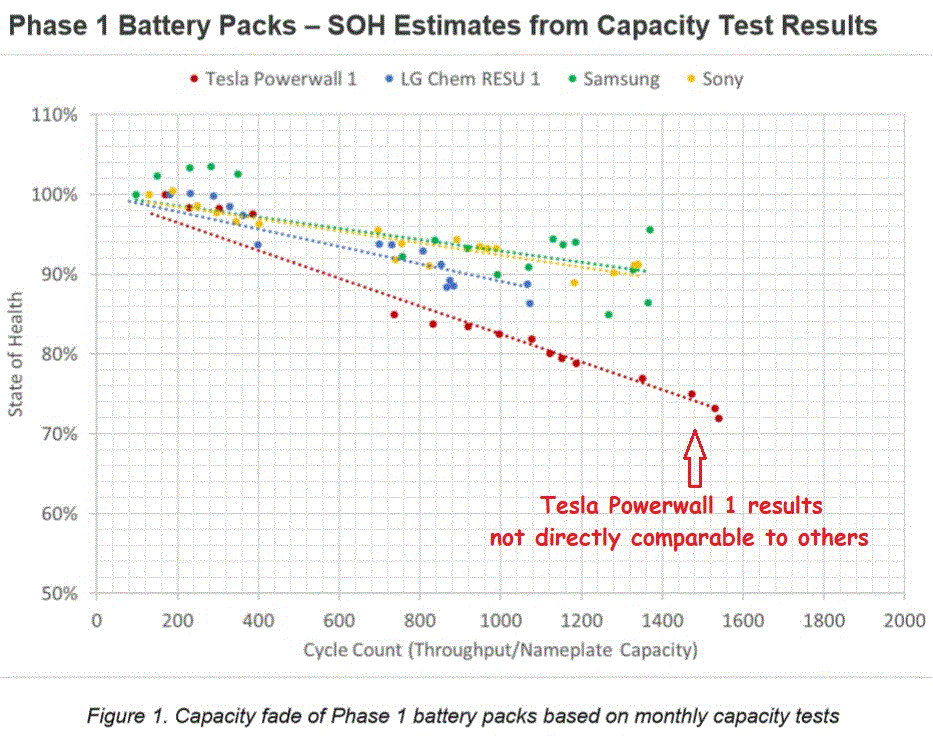
This graph shows the deterioration in capacity of 4 battery systems. I added the arrow and the writing in red Comic Sans. (Image: Battery Test Centre Report 5)
The dots on the graph represent capacity tests. Their locations indicate they were clearly flexible with exactly when the tests were done. I also noticed this…
There’s a gap where no tests were performed for about 80 days. I don’t know why. Maybe the team felt the need to go around the world or maybe they simply ran out of dots and had to wait 80 days to be resupplied.
But despite the gap and despite the considerable variation in test results for the Samsung system, the testers were still able to draw straight lines that best fit the data points. If I assume battery capacity will continue to deteriorate in a linear way and extend those lines for the three systems that had controlled discharges I get this:
This suggests if the battery systems were cycled an average of once per day then after 10 years (3,650 cycles) the percentage of remaining original capacity would be:
- Samsung: 74%
- Sony: 72%
- Original LG Chem RESU: 60%
As households typically only cycle batteries an average of 0.8 times a day, these results should give owners of these systems confidence they are unlikely to fall below the capacity minimums stated in their written warranties.
Original LG Chem RESU Overheating
The original LG Chem RESU being tested has suffered from overheating problems. This is despite the highest temperature is it exposed to is only 36 degrees, which isn’t unusual during Australian summers. The system derates when hot, which means it charges and discharges at a reduced rate. At one point heat forced it to shut down entirely. While this shouldn’t have a major effect in actual use it is still a concern. This model of LG Chem RESU has been superseded and the LG Chem RESU10H used in the second phase of testing has not had this problem.
Phase #2 Batteries: Capacity Deterioration
Phase 2 involved buying 10 battery systems in early 2017. Unfortunately only 5 of them could be tested for capacity fade.
The graph below shows the results:
The graph shows the results of capacity tests, but doesn’t have any lines through the data points for me to extend. Luckily, in addition to the regular tests of capacity, they also estimated battery deterioration from the average capacity discharged and the graph below using this information does have lines through the data points:
If I assume battery capacities will decline in a linear fashion and extend those lines I get this:
Assuming this graph isn’t simply a fantasy based on my need to extrapolate lines beyond what some consider decent and it accurately predicts future battery capacity, then after 10 years of being cycled an average of once per day the percentage of original capacity remaining would be:
- BYD B-Box: 75%
- LG Chem RESU10H: 62%
- Pylontech: 44%
- Alpha ESS: 13%
- GNB LFP: 0%
This is clearly a good result for the BYD battery and suggests there is a large margin of safety built into its written warranty. It only promises to retain a minimum of 60% of its original capacity at the end of approximately 7.8 years if cycled an average of once per day. As it seems set to only degrade by half this much by that point it looks as though one of the world’s largest battery manufacturers knows how to make a durable battery.
The LG Chem RESU10H doesn’t perform nearly as well as the BYD B-Box, but it looks as though it will have a margin of safety when it reaches the end of its warranty. When cycled once per day its warranty will end at around 3,400 cycles, which is 9.3 years. At this point, according to my extrapolation, it will have around 65% of its original capacity left while its warranty promises a minimum of 60%.
The other 3 battery systems did not perform well. The ones that are available now may be significantly better as they’ve had nearly two years to improve, but their poor performance in testing is obviously not a good sign. Alpha ESS have a new line of battery systems that have been approved for South Australia’s battery subsidy, so hopefully they will perform far better than the older model currently being tested.
While it’s possible lithium battery systems will continue to operate until they only have a tiny portion of their original capacity, as the straight lines I drew on the graph above suggest, it’s possible at some point their capacity will fall off a cliff and rapidly deteriorate or the system will spit the dummy, throw up an error message, and refuse to work at all.
Round Trip Efficiency
The estimated DC to DC efficiency of 10 battery systems is shown in the graph below:
This is the round trip efficiency of DC power into the battery to DC power out of the battery. It does not include losses from inverting AC power to DC power or vice versa. If a battery has a DC to DC round trip efficiency of 90% and uses an inverter that is 97% efficient either way then its total round trip efficiency will be under 85%.
Tesla Powerwall 2 Information Coming Soon
Tesla doesn’t allow owners of their battery storage systems to control the product they’ve bought and so the Battery Test Centre has had difficulty accessing their Powerwall 1 and 2. But with Tesla’s assistance they have been able to begin testing the Powerwall 2 and will provide information on it in their next report.
Be Cautious When It Comes To Batteries
I think the lesson to be taken from the Battery Test Centre’s reports is to be careful when choosing batteries. When experts are only able to provide data on half the battery systems they purchase it’s not a good sign. You can greatly increase your chances of getting a functional system by picking one whose manufacturer does good work. But because batteries won’t save most Australians money there is a lot of downside for little benefit.


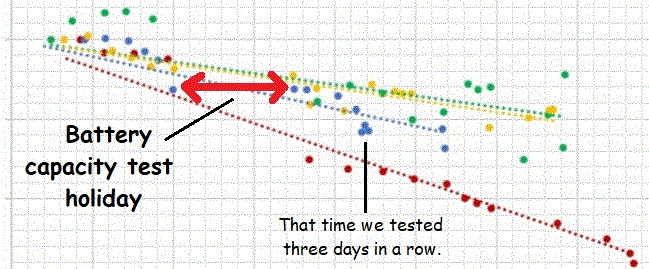
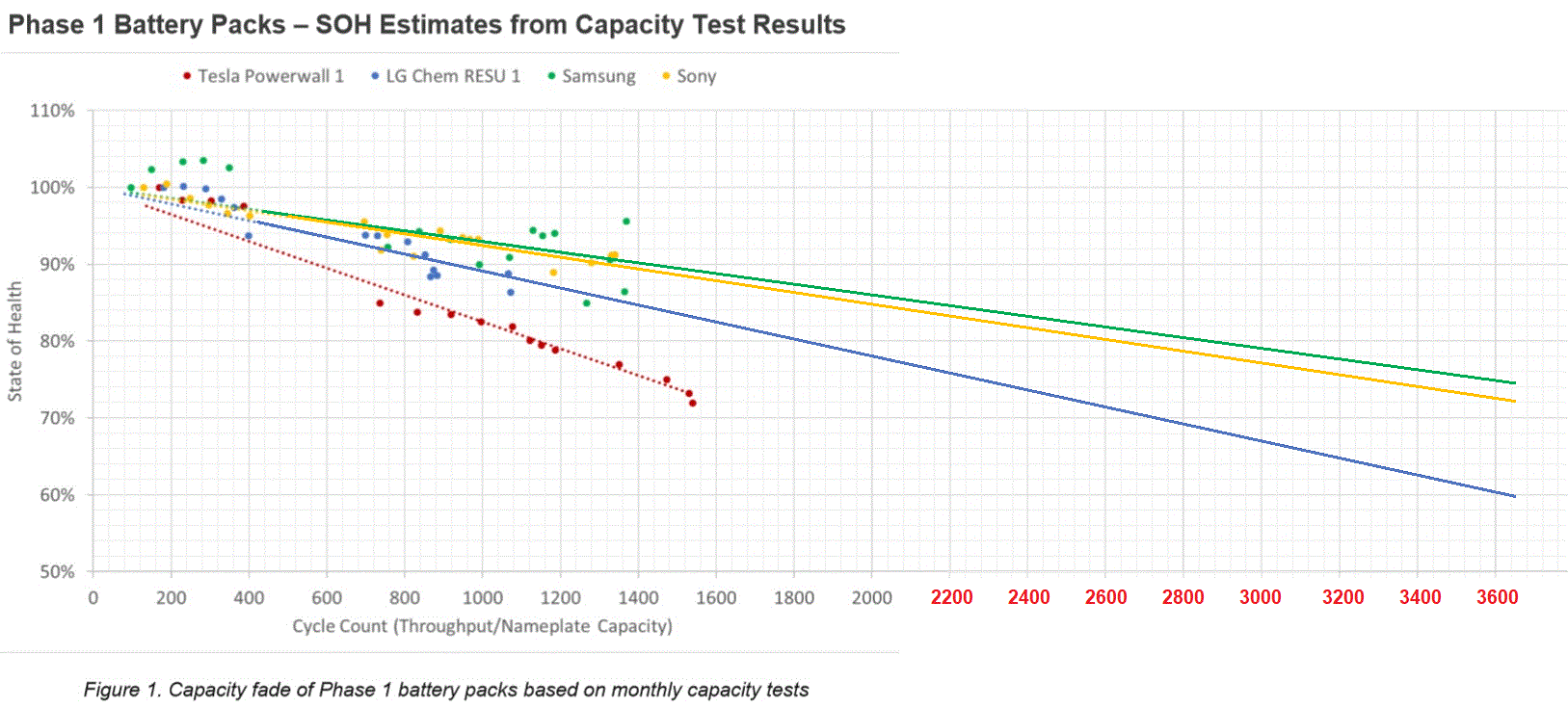
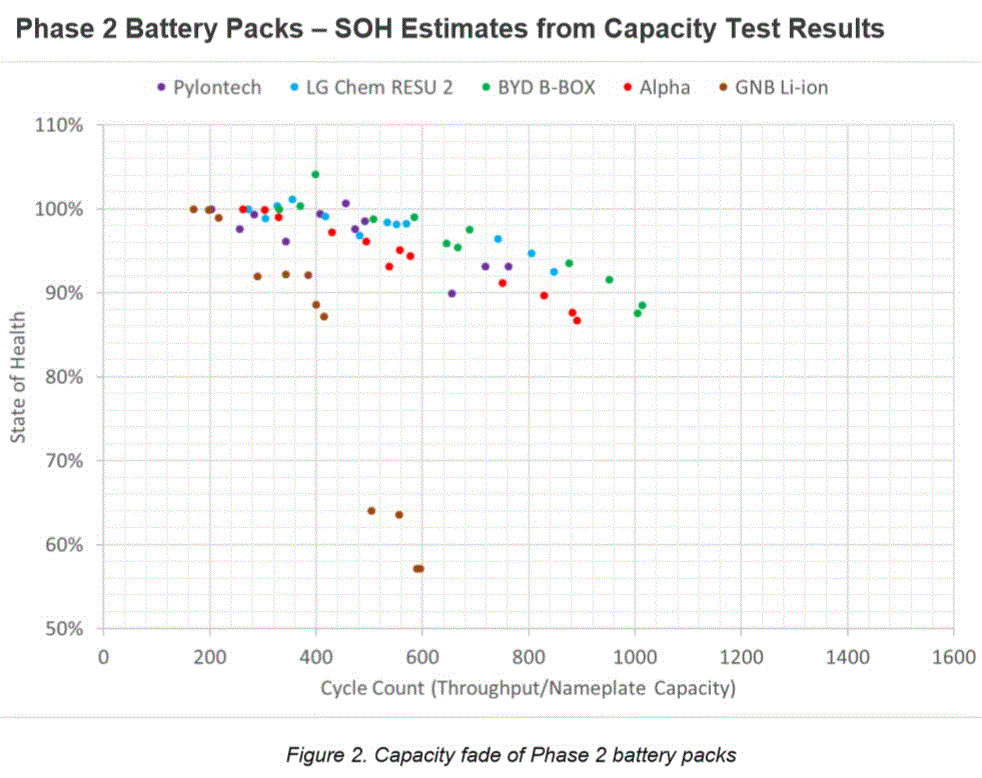
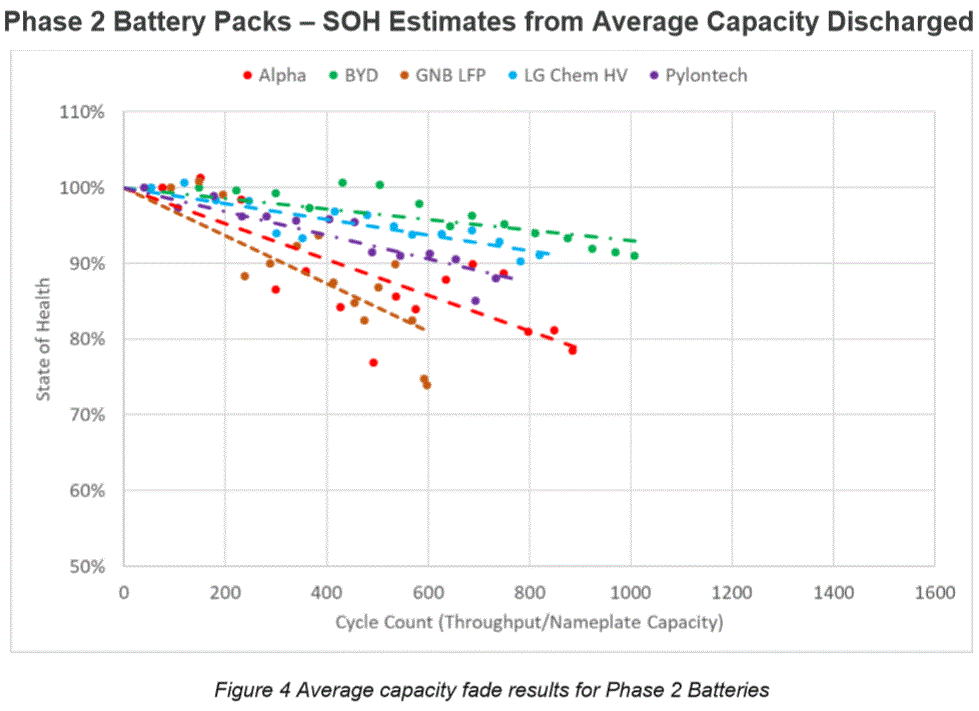
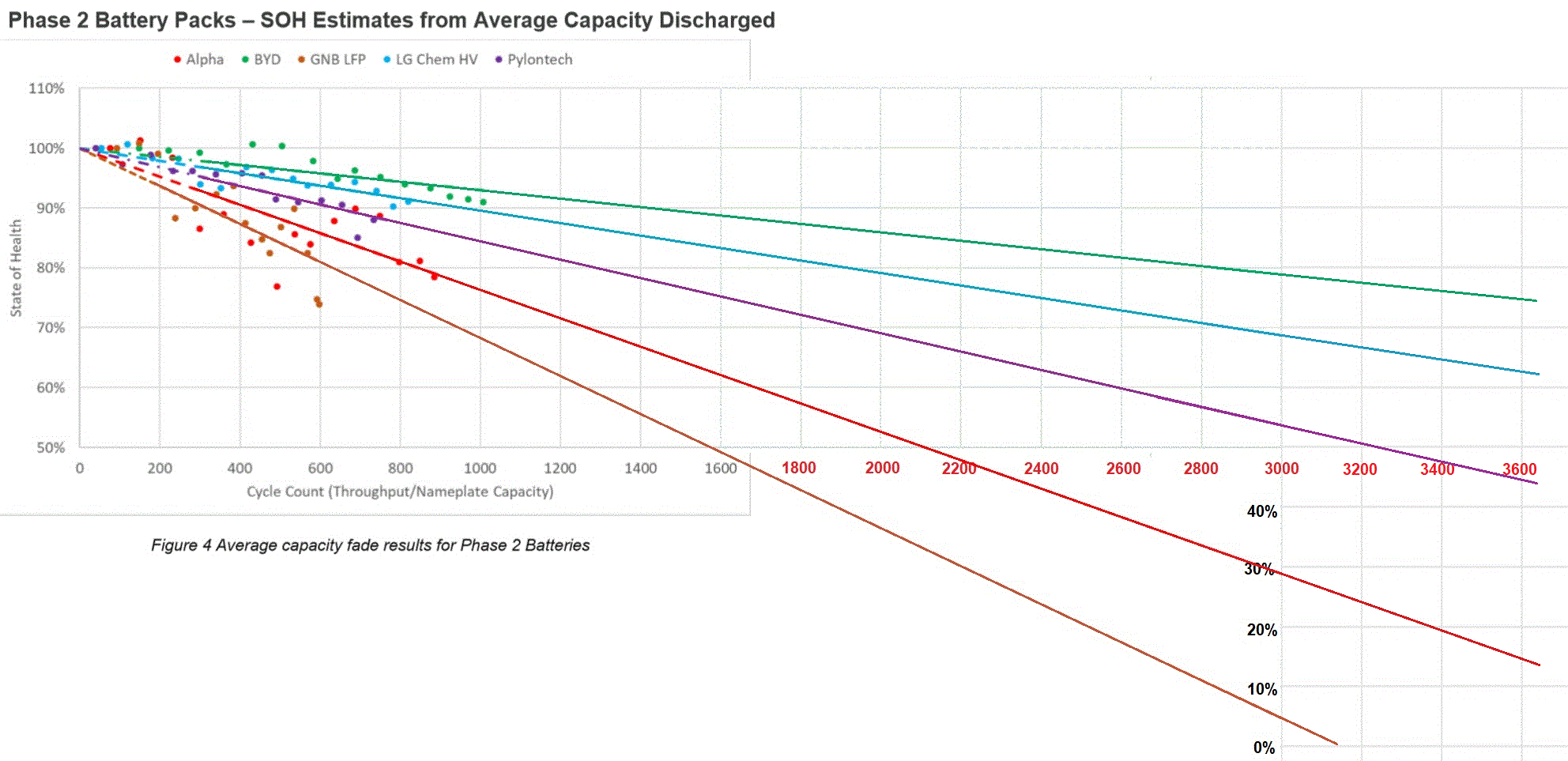
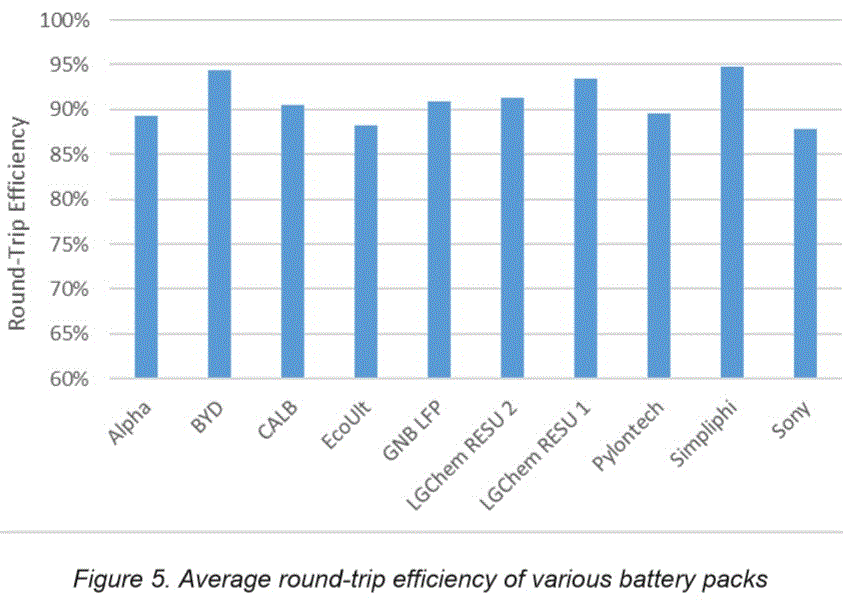
 RSS - Posts
RSS - Posts



“…with Tesla’s assistance they have been able to begin testing the Powerwall 2 and will provide information on it in their next report.”
Looking forward to that report!
Why no Enphase Batteries in the tests?
Very disappointing results.
I expected better from LG, and the entire battery crowd, really.
>3% power year fade.
It would be very interesting to hear the full story on the batteries that were untestable. Its pretty damning if half the batteries just didn’t work or burnt down or what?
Was any hint given whether it was the battery manufacturer’s fault or the test process? Makes me wonder if the process is really representative?
Were the manufacturers given the opportunity to adapt their batteries?
Do we know what the depth of discharge range was? For the last few years I thought a life with 80% DOD (ie down to 20%) was easily over 5000 cycles.
Perhaps it’s a bit like a consumer product testing where they rub a product out because the label was damaged during shipping or a switch failed when the rest of the product might be the best available.
Has any one got data to work out if the whole battery pack failed or just a couple of cells took the lot down?
This is an expensive test not to have acquired a lot of data.
One company (Aquion) went bust pretty much right after the battery arrived and they — despite having all the skills you might need — haven’t been able to get it working. So that’s one that’s never worked in any way and there have been many other problems. I quickly went over some of the problems in my previous long article:
https://www.solarquotes.com.au/blog/battery-test-centre-results/
And all the Battery Test Centre’s reports are available online. (Lawrence kindly gives a link to them above.)
Ron there is a lot more to be learned by a visit to ITP in Canberra. They are very helpful to those who visit and I commend their transparency in all things.
Here are the 5 reports promulgated so far.
https://batterytestcentre.com.au/reports/
Lawrence Coomber
Graham this storage battery subject is more nuanced than you imagine.
The focus has always been on the battery pe se and this has led inexperienced young engineers, technicians and system designers up blind alleys regarding semi intelligent systems design that bullet proof “Semi Intelligent Energy Solutions” using batteries.
The focus has been skewed – the “battery” has taken precedence over the “system”.
The battery might be visualized as the car engine “whoopee” I have seen them rolling off assembly lines everywhere, but unless some level of logic control, or semi intelligence is integrated with the secondary player (the car engine) it remains a useless lump on a pallet forever.
It is almost incomprehensible that we find ourselves globally at this low battery management technology level in this day and age. The EV technology world is gradually leading the climb out of this abyss at the moment but even that sector is struggling. Let’s not forget, EV’s can never really aspire (in the foreseeable future) to go beyond a maximum penetration in the global vehicle fleet of about a maximum of < 1.0 % at best. This is still a lot of EV's though.
The renewable energy storage technology sector is really struggling and has been very slow to interpret and define its own systems design imperatives regarding “semi intelligent battery storage systems design” standards. At the basic building blocks level, not much has really changed since Nimbin 1965 really.
That’s about enough.
Lawrence Coomber
Is the Redflow battery being tested? I am interested to see results from third party testing on this battery.
They have a Redflow ZCell but it has had some problems and been replaced three times. Twice because of electrolyte leaks. They may be able provide more testing information on it in the future.
Has anyone looked into Nant Energy’s zinc air batteries. According to their website they are a much better solution the Lithium.
Given the rapidly falling price of lithium battery cells I don’t see how zinc air can compete in the area of home & business energy storage, but if they think they can make a system that’s competitive, good luck to them.
So… wouldn’t be doing my job if I didn’t ask…
Help me understand what “under test conditions its discharges were uncontrollable” means.
I have a vision of these batteries being tested by applying a known charge and a known load for set periods of time. Was that not the case for this test?
If I plug in a 1800W hairdryer and run it for one hour I expect 1800W.h of energy to be used. If I’m using a battery and inverter I expect the battery discharge to be a little more than that due to some efficiency losses in the system… but again I expect that to be a quantity that can be easily measured and known. It is not my expectation that the hairdryer will detect a surplus of available energy, develop a severe case of megalomania and become some sort of mad scientist death ray, dispensing murderous beams of scorching heat in a fashion that could at best be considered uncontrollable.
Is this not a reasonable expectation?
Tesla doesn’t allow end users complete control over its Powerwall 1 & 2. So they were able to set up the other battery systems that worked to discharge at around 1/3 C. That’s one kilowatt charge or discharge per 3 kilowatt-hours of battery storage. But with the Powerwall 1 they couldn’t control it as they wished and could only get it to charge and discharge at about 1/2 C. This puts the battery under more stress and results in it getting hotter which isn’t good for its life span. But if the Powerwall 1 had been set up normally in a home rather than a test centre it would have functioned properly.
Ronald,
The PW1’s continuous rated power output is 3.3kW. Changed from 2kW when public reaction included “couldn’t boil a kettle”
The PW1 was intended to be used with SolarEdge’s “Storedge” inverters. The maximum battery is DC input is 3.3kW, but also controlled by management software.
3hr (2kW) charging and discharging limits the throughput of the battery, because it’s more dependent upon circumstance, rather than direct control according to immediate demand and solar input.
Whatever, the result is well below the verbally claimed 5000 cycle,15 year operation.
Thanks Ron, but I still don”t get it. Could they not have simply selected a smaller load to discharge the battery at a lower rate?
Or, is there some confounding software override that does not allow the inverter to kick in until the load gets above a surprisingly large threshold?
You may be able to find some details of their setup in their reports but rather than have a fixed load I would guess that want the batteries to discharge at a constant rate into the grid. After all, why waste energy? That way they’ll get a feed-in tariff for any surplus power.
Scott,
The load for the batteries is the grid. Rather than using constant current discharge, ARENA employ a constant power load determined by the inverter.
The SMA inverter can employ closed loop control to set a constant power output. In this case, 2kW or 1/3 C as required.
The PW1 can only operate with the SolarEdge inverter. When connected to the grid, will demand the maximum battery input of 3.3kW, without means of controlling the level. In practice, the household load will determine the power output up to 3.3kW. When connected to the grid, will simply operate at full power.
the qld. govt battery scheme ,is not all what it seems , speaking to a solar battery provider , there is a $4000 fee to be a registered installer and a 2% turnover tax on the carbon credits .
something that you may want to look into
cheers don
From a different web page in this blog –
“You are posting comments too quickly. Slow down”
BS!
I do not know how many days have passed, since I last posted a comment to the blog!
I appreciate the effort in bringing this study to light. It was of great help in attempting to figure out a future battery bank.
I have recently been making a study of my own in trying to size a battery bank for my home.
I am using solar energy year round from solar panels to run daylight loads such as home appliances, a hot water heat pump, etc.
At night I have already figured out what is the maximum amount of energy that I require for the coldest night of the longest night.
I figured that to minimize the number of battery bank purchases over say the next 20-years that I need to initially oversize the battery bank to meet my energy demands on the longest and coldest night 20-years from now.
What would be a safe, correct way of designing this battery bank?
Cheers,
Eric
What’s your plan Eric moving your battery stack design to integration, testing and set to work? You are dabbling in a subject area where serious qualifications and experience are critical.
You have earlier mentioned Nickel Cells are of interest to you, but whatever battery/capacitor chemistry or multiple chemistry hybrid battery designs you come up with, dont spend your money without discussing your ideas with an experienced power engineer.
You are entering a potentially dangerous place dabbling with even a single 18650 Li cell Eric.
Lawrence Coomber
Hi Lawrence,
I like to call myself a man who sees a half empty glass as an almost full glass.
What about you?
You have been very kind in your responses, but you do not provide any down to earth nitty gritty advice. You seem to prefer that I wait or do nothing.
Well, I am not like that. I like to ask questions, and I like to get straight forward answers, and then I like to think about those answers until I can find an answer to my problems.
So, by the time I sit down with a power engineer, I will know the answer to most of my questions.
In addition, people always have agendas in mind, and I need to understand the problem to know who is talking with me.
So, this is why I am here.
In the above question, I am exploring a second battery chemistry to my preferred choice just for kicks, and I am trying to understand what other set of variables are normally chosen by people more familiar with this area to see if I missed something.
Now is that so wrong? I thought that this was the whole purpose of this blog, but perhaps, I am in the wrong site.
Cheers,
Eric
Eric contact me direct by email at any time if you would like some more detailed and practical advice on BESS for On Grid. I operate in this space.
Lawrence Coomber
I admire your interest and involvement in your project Eric.
Speaking as you have though about batteries and energy requirements for circuits and long winter nights, and oversizing of batteries – seems to imply that you might be a suitable candidate for adding an Off Grid system to your premises whilst maintaing your existing on grid system as the secondary support system rather than the primary system. This is a viable and cost effective design concept for premises with large or heavy duty cycle loads (heating cooling machinery or equipment typically), when certain stars line up.
So your starting point is to accurately quantify your load circuits Eric and every household will differ with power requirements and this difference can be large.
If you fall into the high power user catergory and are comfortable investing in a higher than normal (or complete) dependance on reliable and enduring PV and battery solutions rather than Grid source entirely, then exploring options like above are certainly worth discussing.
And keep up your interest and involvement Eric I look forward to hearing about your project unfold.
Lawrence Coomber
Greetings one and all. There’s points in the blog that are eye-opening, some mouth watering in that in real world performance ‘some’ batteries like BYD may perform well. I’m in Africa where the grid is unreliable and the information on reasons can be politicized, or downright hidden so extensive research with multiple sources is not an option. The products themselves don’t come with any subsidies so spending money that is limited only to be led down the garden path into the dark rabbit hole is undesirable.
BYD & Pylontech US3000 seem to be the best options, though not both are not cheap and so I’m trying to figure out which would be best to run with a Deye 5Kva Hybrid Inverter. At one point Pylontech seemed to rule the roots at another, BYD over a long time, so it’s unnerving to have uncertainty and fluctuations.
Pylontech offers advantages when it comes to space constraints, BYD seems a better performer… then comes the fact that battery tests and data sheets don’t match.